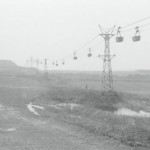Naomi Kawase’s Mourning Forest could be used as a template for the kind of film I love. A slow, moving camera that captures images of nature, with an almost fetishistic fascination with wind blowing through trees and tall grass. Nearly wordless characters, whose desires and pain are expressed instead by their faces, which we’re allowed to watch closely and intimately. A curiosity about essential things like faith and love and loss. Oh, and the desire for transcendence, of course. It’s a ready-made Long Pauses kind of film. Except that it isn’t. Girish and I have been trying to understand why we’re the only people among our group of like-minded friends here who were disappointed by Mourning Forest. (And, for the record, to say that I was disappointed is not to say it isn’t an interesting film.) The story concerns a young woman and elderly man, both of whom have suffered a great loss. For the first half of the film, we watch them going about the routines of daily life at the retirement home where she works and he lives. I was quite liking the film until they began their journey through the forest, at which point I was instantly reminded of other similar, more compelling movies. I think Kawase’s handheld photography was part of the problem for me. It seemed at odds with the tone of the film. But mostly I was frustratingly unmoved by the two leads, and the last image of the film — that inevitable grasp at transcendence — was too calculated and a little clumsy. But don’t listen to me. Everyone else loves it.
The general consensus at the festival is that The Man from London is minor Tarr. I’ve been ambivalent about the other two films of his that I’ve seen, Damnation and Satantango. As the latter film proved, I will gladly sit for hours and hours and hours in front of his films. (Question of the day: Has any director in the history of cinema had a more distinct style?) The camera moves slowly, the actors speak slowly, the music churns slowly, and as a result “real” time is compressed. I couldn’t believe, when The Man from London ended, that 135 minutes had passed. My qualms with Tarr have always concerned his view of the world, which is too misanthropic for my tastes. Which is probably why his latest film is my favorite of the three. I keep calling it a film noir that was left to simmer over low heat, reducing the genre to its fundamentals: man is trapped, man finds money, man attempts to escape fate. Friends look at me funny when I tell them how much I liked the protagonist, who in typical Tarr fashion has little to say. But in his own way, he’s actually quite tender at times. (That I managed to use the word “tender” here is probably another reason for disappointment from the Tarr loyalists.) As usual, The Man from London is a joy to look at. His camera is still tracking for minutes at a time, and he’s thrown in a couple new tricks. The 12-minute opener is a doozy. Also, Tarr stuck around for a Q&A and didn’t bite off a single head. He was charming, actually, and really funny.
Jia Zhang-ke’s latest, Useless, is an odd one. Like last year’s documentary, Dong, Useless is a portrait of an artist, though in this case Jia is less concerned with fashion designer Ma Ke, specifically, than with what she represents to China’s leap into consumerism. In a recent interview, Wang Bing (see yesterday’s post on Wang’s latest) mentions that one reason he is not making narrative films right now is because “in China, social changes have come so fast and been so massive, that the opportunities for documentaries are considerable.” I suspect that Jia feels the same way. Useless, the title, comes from the name of Ma Ke’s haute couture line fashioned from traditionally hand-made fabrics. The middle third of Jia’s film documents the line’s impressive debut at Paris’s Fashion Week and includes interviews with Ma in which she waxes nostalgic about the human touch and artistry that is missing from mass-produced clothing. As we’ve learned in the first act of the film, though, Ma is only able to concentrate her efforts on Useless because of the fortune she made with Exception, which seems to be the Chinese equivalent of Banana Republic. Jia opens the film with a tour of the facility where hundreds of workers hunch over sewing machines, manufacturing garments for the chain of Exception store fronts. The shots are mirrored in the second act, when Jia shows two Chinese women hunching over weaving machines to produce the “hand-made” fabrics for Useless. The film ends in a rural mining town, where Jia follows several locals, including two tailors and a former tailor who was forced by the low cost of manufactured clothes to take a job at the mine. This quick summary lays out the macro-structure of Useless, but its the finer points — the visual echoes that reverberate throughout the film, the ironies and ambivalences — that make the film so fascinating. I like it better the more I think about it.
John Gianvito’s Profit Motive and the Whispering Wind recovers the lost history of class struggle in America by filming, in simple, static shots, the monuments left behind: commemorative plaques, statues, and, most often, cemetery headstones. Gianvito structures the film chronologically and breaks the sequence of shots only on occasion to show images of wind blowing through leaves and grass (shades of Whitman and the Transcendentalists) and to interject jarring hand-drawn animations that represent the impersonal, amoral transactions of capitalism. The relative simplicity of the form allows the film to function pedagogically (I came away with a list of names and events I want to explore), but it also leaves room for the viewer to create connections and find new contexts. We can chart, for example, the movement of civil rights from New England to the South, and, likewise, the movement of manufacturing from the South to the Midwest. Or, in my favorite cut of the film, we learn that the founder of America’s first labor organization lays in an unmarked grave, while, at the same time, Sojourner Truth was being buried under an oversized headstone. In 1883, apparently, an African-American woman could be commemorated with greater honor than a white male labor organizer. Fascinating.
Ute Aurand and Maria Lang’s The Butterfly in Winter is a 30-minute silent portrait of Lang’s life at home, where she tends to her 96-year-old mother. Each day begins with the opening of her mother’s bedroom window, a glass of water, breakfast, a wash and massage, and ends with a whisper in her hear and the closing of the window. Aurand assembles their life in jump cuts and closeups, revealing the slight variations amid the routine. I like Andrea Picard’s description: “Every day is the same and every day is different.” There’s such beauty and sweetness in the film.


